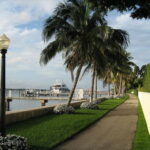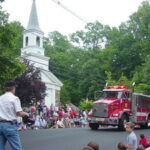The last tornado in the United States to kill as may as ninety people, the Worcester Tornado of 1953 had winds estimated at over 317 miles per hour. The Worcester Tornado touched down in central Massachusetts in the late afternoon of June 9th, 1953, and for the next 84 minutes it obliterated everything in its path. The damage the Worcester Tornado caused was so severe that many residents, at the height of the Cold War, thought that the Russians had dropped an atomic bomb. Congress would actually debate in the weeks after the Worcester Tornado if the atomic bomb testing that had been occurring in the upper atmosphere was responsible for this and other related monster twisters that ravaged the States during 1953.
The same storm system that spawned the Worcester Tornado also had created one a day earlier in Flint, Michigan. The Flint Tornado had been an F-5 on the Fujita scale, meaning it was the absolute worst of cyclones. It had killed 116 people before dissipating, making it the ninth deadliest tornado to hit in the United States. The tracking by radar of such storms back in 1953 was not possible since the instrumentation was so crude, and on that fateful day in Massachusetts the Boston Weather Bureau had predicted thunderstorms, stopping short of warning against potential tornadoes to avoid panicking the people, who were hearing the news of the Flint destruction. Before the day was done, the strongest tornado ever to hit New England would etch itself into the memories of all those that felt its power for the rest of their lives.
The Worcester Tornado began over the Quabbin Reservoir at 4:25 in the afternoon near the town of Petersham and continued along the ground for 46 miles. It tore through the towns of Barre, Rutland, Holden, and then finally hit northern Worcester, the state’s second largest city with a population at the time of 200,000 citizens. Winds that may have been the highest ever seen, certainly the highest ever in New England, sucked the water out of ponds and annihilated buildings, picking them up and sending them everywhere at once. Chickens had their feathers torn off, the paint was removed from cars by the incredible power of the air, and one man actually had his chest explode due to the pressure from his expanding lungs.
New England rarely experiences a tornado, especially one of the magnitude of the Worcester Tornado, but the fear of an attack from Communist powers was rampant during the early 1950s, and people had been told what to do in case of such an event. Everyone found the nearest shelter, whether it was their basement or their closet, and waited as the Worcester Tornado passed. Roofs were torn off of homes as the tornado, which sounded like a freight train, swept from one town to the next. Houses were reduced to splinters, and eyewitnesses watching the Worcester Tornado at first thought that it was being circled by a “huge flock of birds” until they saw that it was actually trees, lumber, and even telephone poles that had been carried up into the sky by the howling winds.
At 5:08 the tornado reached Worcester where the force of its winds picked manhole covers up off the streets and rolled them away like Frisbees .A twelve ton bus was picked up, rolled over several times and then thrown through an apartment building, killing two passengers. A priest and two nuns at Assumption College perished in the Worcester Tornado, as did six workers at the Brookside Home Farm, along with most of the eighty cows located there. The roof was blown off of the city’s largest employer, the Norton Company, which had just completed their new six million dollar factory. The more modern sections of Worcester had seen most of the houses built on slabs, minus a basement, and these homes were literally just wiped off the map, leaving only cement behind. Debris from this powerful cyclone landed as far as thirty-five miles away and some of it reached the Atlantic. The Worcester Tornado was a mile wide as it went through Shrewsbury and then into Westborough, finally ending at 5:45 in Southborough, after it had spawned a pair of much lesser twisters that did minor damage in Franklin and Wrentham.
The final death toll was 94 people when all was said and done, 60 of those coming from Worcester. 1,288 were injured, ranking the Worcester Tornado as the fourth worst in American history in that regard. The fifty-three million dollars worth of damage inflicted on these Massachusetts cities and towns made the storm the costliest up to that point, and over fifteen thousand people were left homeless. In the aftermath, dazed residents surveying the frightening damage were sure the Russians had used a nuclear weapon on them. For years meteorologists debated whether the Worcester Tornado was an F-4, as it was originally classified, or a more powerful F-5. In 2005, the Worcester Tornado was decided to be an F-4 by the National Weather Service, not that it mattered to any of the folks who were lucky enough to live through it that day fifty-two years earlier.




